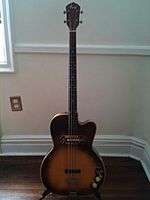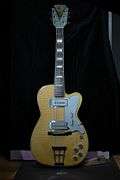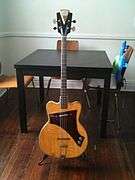Kay Musical Instrument Company
Kay Musical Instrument Company was a US musical instrument manufacturer of the United States, in operation from 1890. Kay was established in 1931 in Chicago, Illinois, by Henry "Kay" Kuhrmeyer, from the assets of the former Stromberg-Voisinet (founded as "Groeschel Mandolin Company" in 1890).
 | |
| Private (1890–1969) Brand (1969–present) | |
| Industry | Musical instruments |
| Fate | Company defunct in 1968; Brand acquired by W.M.I. in 1969 |
| Predecessor | Groeschel Mandolin Co. (1890), Stromberg-Voisinet (1921) |
| Successor | Weiss Musical Instruments (1969-1980), The Kay Guitar Company (1980-present) |
| Founded | 1931 |
| Founder | Henry "Kay" Kuhrmeyer |
| Defunct | 1968 [1] |
Key people | Sidney M. Katz Tony Blair |
| Products | Electric, lap steel and acoustic guitars, double basses, violins, cellos, banjos, amplifiers |
| Brands | List
|
| Parent | Valco (1967–68) [1] |
The company produced instruments in its plant until 1968, when it ceased operations after a brief merging with Valco. In 1969, rights to name "Kay" was acquired by Weiss Musical Instruments (WMI) . The brand has been used by several manufacturers since then, mainly attached to Japanese import guitars.[4][1]
Kay offered their first electric guitar in 1936 — five years after the Rickenbacker Frying pan, and the same year as the Gibson ES-150. However, the Kuhrmeyer-owned Stromberg-Voisinet brand had produced the "Stromberg Electro" even earlier, in 1928, making the short-lived model arguably the first commercial electric guitar.[5][6][7][8]
Overview
Early history (1890–1931)
The Kay Musical Instrument Company grew from the Groeschel Mandolin Company (or Groeshl Instrument Company[10]) in Chicago, established in 1890.[11] In 1921, the company was renamed to Stromberg-Voisinet. In 1923, later president Henry Kay "Hank" Kuhrmeyer joined the company, and in 1928, with the help of an investor,[11] he bought the company and started producing electric guitars and amplifiers.[12]
The new company, "Kay Musical Instruments" was formally established in 1931[1] from the assets of the former Stromberg-Voisinet company by Kuhrmeyer. As its predecessor had primarily commercialised its products under its own brand as well as a large number of other brands, Kay Musical Instruments would continue that practice.[1]
Activity on Kuhrmeyer-era (1931–1955)
The company initially manufactured only traditional folk instruments such as mandolins, tenor guitars and banjos,[1] but eventually grew to make a wide variety of stringed instruments, including violins, cellos, double basses and a variety of different types of guitars, including electric, classical, lap steel and semi-acoustic models. Some of Kay's lower-grade instruments were marketed under the Knox and Kent brand names.
In addition to manufacturing instruments for sale under its own brands, Kay was also a prolific manufacturer of "house branded" guitars and folk instruments for other Chicago-based instrument makers and, at times, for major department stores including Sears and Montgomery Ward.
Kay also made guitar amplifiers, beginning with designs carried over from the old Stromberg company. Kay eventually subcontracted its amplifier production to Chicago music industry rival Valco in the 1950s.
Decline on Katz-era (1955–1968)
After the retirement of Kuhrmeyer in 1955, the company was taken over by Sidney M. Katz. The product line of Kay was shifted toward electric musical instruments on demands, and in 1964, the company moved to a new factory in Elk Grove Village, Illinois. In 1965 Katz sold Kay to Seeburg Corporation, and he became the head of Seeburg's musical instrument division. In 1967, Kay was resold and merged with Valco, but dissolved in 1968 due to financial problems.[11]
Revive (1969–present)
The assets of Kay/Valco were auctioned off in 1969. The upright bass and cello lines were sold to Engelhardt-Link, a new company formed by a previous Valco member, which has continued production (see #Kay basses for details). The Kay name (and some of its trademarks, such as Knox were acquired by Teisco importer, Weiss Musical Instruments (WMI, by Sol Weindling and Barry Hornstein),[2] who put the Kay name on the Teisco products beginning in 1973, and continued on through the 1970s.[13][14]
In 1980, A.R. Enterprises (Tony Blair) purchased the Kay trademark.[14] In 2008-2009, The "Kay Guitar Company" of California reissued 12 models of vintage Kay guitars and basses[15] manufactured by Fritz Brothers Guitars.[16] As of 2013, production and sales of these guitars have continued.[17]
Kay guitars
Kay was best known for its mid-priced guitars, (i.e., quality guitars priced below top-of-the-line instruments like Gibson and Gretsch models) as well as its budget instruments. Kay made guitar models for its own brand name and guitars branded as Silvertone for Sears, Sherwood and Airline for Montgomery Ward, Old Kraftsman for Spiegel, Rex for Gretsch, Custom Kraft for St. Louis Music,[2] Truetone for Western Auto,[3] 'Penncrest' for JC Penney, etc.[20] Also, Kay produced a line of archtop acoustics called Kamico.
Kay's current line includes low-priced acoustic, electric and bass guitars, and moderately priced banjos, ukuleles, mandolins and resonators. They also sell the Chicago Blues line of inexpensive harmonicas.
K-161 Thin Twin guitar and K-162 Electronic Bass

One of the best known Kay electric guitars during the 1950s was the K-161 "Thin Twin", most visibly used by blues artist Jimmy Reed. This instrument debuted in 1952, and featured a single cutaway body, a distinctive "fire stripe" tortoiseshell pickguard, and a pair of thin blade-style pickups that gave the guitar its name. Kay used this type of pickups on various Kay electrics dating back to the 1940s.
Also in 1952, Kay introduced the matching K-162 "Electronic" Bass, which was the first commercially available thinline-hollowbody electric bass guitar, and the second production electric bass guitar after the Fender Precision Bass debuted in 1951. Due to the use of K-162 by a bassist of Howlin' Wolf, Andrew "Blueblood" McMahon, it is commonly known as the "Howlin Wolf" bass. These instruments are believed to be the first semi-hollow electrics (i.e., thinline-hollowbody electric with solid center-block), predating the Gibson ES-335 by six years. Their unique design featured a flat top with no f-holes, a free-floating arched back, and two braces running along the top. The result was a semi-acoustic instrument that was feedback-resistant while retaining natural acoustic resonances. In 1954, Kay added the K-160 bass to its catalog with baritone tuning, according to the catalog, "tuned like the first four guitar strings but one octave lower." Structurally this bass was basically same as K-162 bass, except for the higher pitched tuning and the addition of a white pickguard.
In the late 1950s, various guitars in the Kay line were assigned new model numbers; according to the 1959 catalog, the Thin Twin became K5910 and the Electronic Bass became K5965.[21] Both instruments remained in Kay's catalog offerings with only minor cosmetic variations until 1966, when Kay revamped its entire guitar line to only feature budget instruments. Kay also manufactured versions of the Thin Twin guitar under the Silvertone (Sears) and Old Kraftsman (Spiegel) brands.
Gold "K" Line
In 1957, president Sydney Katz introduced the Gold “K” line of archtop and solid body electric guitars[16] to compete with major manufacturers like Fender, Gibson, and Gretsch. The gold “K” Line featured the Jazz Special, Artist, Pro, Upbeat,[21] Jazz II, and Jazz Special Bass. Gold “K” guitars used the same hardware as top manufacturers. However, there were truss rod and neck issues.
Gold models had single coil pickups with clear silver plastic covers and phillips head bolt adjustable pole pieces. The Upbeat model came with an optional transparent black plastic cover. The Jazz Special Bass has a single blade pickup as used on the K-161 and K-162 (tilted slightly towards the neck at the treble side), as well as a distinctive, oversized headstock.
Valued among collectors, the headstocks from 1957-1960 featured a reverse painted plastic overlay similar to the Kelvinator logo. The guitars featured art deco patterns. It was difficult to get players to take Kay's high end entry seriously, and Kay discontinued the Gold line in 1962.
"Kamico" guitars were lower-priced versions of Kay's original guitars. They were among the first guitars to use a humbucker type pickup, predating Gibson by some few years. Produced along with Kay brand name guitars from 1931–51, according to most sources.[22][23] The most recognizable model is the Jumbo Jazz. Kay also made banjo's under the kamico name.
Kay basses
%2C_f-hole.jpg)
In 1937, Kay began to produce a 3/4 size upright bass, which is widely believed to be their Concert or C-1 bass. Like their guitar manufacturing, the basses were hand crafted by skilled craftsmen using special ordered machinery. They even had a hot stamping machine that could emboss the trademark KAY cursive script.
After the dissolve of Kay/Valco in 1968, the Engelhardt-Link Company bought the upright bass and cello lines at the asset auction in 1969, and continue to produce the same instrument lines till today. Manufactured in Elk Grove Village, Illinois, Engelhardt basses and cellos are sturdy instruments, widely used by students and touring professionals. The ES9 Swingmaster bass (formerly the Kay S9 Swingmaster), is highly thought-of by jazz, swing, and bluegrass musicians.
Notable players
- Alvin Youngblood Hart [note 1]
- Anne Erin Clark [note 2]
- Arthur Crudup
- Barney Kessel [note 3]
- Beck
- Big Joe Williams
- Bill Black [note 4]
- Bob Casale (Devo)
- Bob Dylan
- Brad Paisley
- Brad Whitford
- Bruce Springsteen [note 5]
- Buddy Guy
- Chet Atkins
- Darryl Jones (The Rolling Stones)
- Dave Grohl
- Elmore James
- Elvis Costello
- Elvis Presley [note 6]
- Eric Clapton
- Francis Hillman Blackwell
- Gaby Moreno
- Gary Moore
- George Montgomery
- George Harrison
- Howlin' Wolf
- Jack White
- James Hetfield
- Jeff Tweedy
- Jerry Garcia
- Jimi Hendrix [note 7]
- Jimmy Reed [note 8]
- Jimmy Vivino
- Joan Jett
- Joe Hill Louis
- Joe Walsh
- John Fogerty
- John Lee Hooker
- Keith Richards
- Louis Allen
- Mark Knopfler
- Mike Rutherford [note 9]
- Paul McCartney [note 10]
- Paul Stanley
- Pete Townshend
- Phil Alvin
- Randy Jackson
- Robert DeLeo and Dean DeLeo (Stone Temple Pilots)
- Robert Pete Williams
- Roscoe Holcomb
- Rudy Sarzo
- Ry Cooder [24]
- Sam Hopkins
- Sam Pallidio (Nashville T.V. Show)
- Sarah McLachlan
- Sean Hurley
- Shark
- Sheryl Crow
- T Bone Burnett [note 11]
- Tom Morello
- Tom Petersson
- Tom Petty
- harles Candler Rosser
See also
Bibliography
- Scott, Jay (1992). 50’s Cool: Kay Guitars. Second String Press. pp. 64 pages. ISBN 978-1-880422-01-4.
- Fjestad, Zach. "KAY". Blue Book of Acoustic Guitar Values. Blue Book Publications, Inc.
"Source: 1950s/1960s company history courtesy Jay Scott, 50's Cool: Kay Guitars, contemporary history courtesy Michael Wright, Vintage Guitar Magazine, individual model listings: Michael Wright, Guitar Stories, Volume Two."
See also: Mayflower, Kay Kraft.
Notes
- American blues guitarist/songwriter.
- Singer/songwriter for the group St. Vincent.
- American jazz/blues guitarist/session musician prominent in the 1950s and 1960s. Kessel endorsed the Kay "Jazz Special", "Artist" and "Pro" guitars. As of 2016 the Barney Kessel name has been assigned exclusive manufacturing rights with the Kay Guitar Company. Kay is now reissuing the 1960s signature models (Barney Kessel Pro, Barney Kessel Artist, Barney Kessel Jazz Special). Contrary to some misleading stories, Barney Kessel often played Kay Guitars and can seen on video playing a Kay Jazz Special Guitar on the T.V. series Johnny Staccato, "Television's Jazz Detective".
- Upright bassist for Elvis Presley. Can be heard on "Heartbreak Hotel" and many other classic Elvis Presley recordings.
- Bought his first guitar at a Western Auto Store for 18 dollars.
- His first guitar was a 1947 Kay flat top K19 purchased at Tupelo Hardware by his mother Gladys as a birthday present.
- Played a 1967 white Kay electric “Strat” copy.
- Reed's guitar tone is the most famous example of the unique, thick & biting "Kay sound.".
- Used a Kay Speed Demon in the music video for the Genesis song I Can't Dance.
- Played a black K5970 Kay Jazz Special Bass guitar on Wings' Red Rose Speedway album. This Bass also appears in the official music videos for "Junior's Farm" and "Ebony and Ivory".
- Known for playing the Kay K161 Thin Twin electric guitar http://kayvintagereissue.com/vintageplayers.php.
References
- Kay History on Chasing Guitars website
- 1963 Truetone Jazz King on YouTube
- "Trademark 72207542". – "Truetone" was a registered trademark for musical instruments owned by Western Auto since 1964/1966 until 1989 (or since 1945/1947 until 1992 for radio receiver on trademark 71485315).
- The Story of Kay Guitars, Told in 10 Reverb Listings by Frank Meyers, Jul 18, 2017 por Frank Meyers
- Michael Wright (February 2000). "1000 Years of the Guitar, Part 2". Vintage Guitar.
- Lynn Wheelwright (September 2008). "Stromberg Electro". Vintage Guitar.
-
"New Sales Avenue Opened with Tone Amplifier for Stringed Instruments". The Music Trades. October 20, 1928.
This tone amplifier is electrically operated either by alternating or direct currents. It consists of two major units -- an electro-magnetic pick-up and amplifying unit. The electro-magnetic pick-up is built within the instrument and is attached to its sounding board. The unit is connected with the amplifier, which produces the tone and volume required of the instrument.
-
Stromberg Electro Instruments (advertisement on catalog). Chicago Musical Instrument. 1929.
Operated from light socket alternating current. No batteries required.
- "1916 Kay Catalog" (PDF). Kayvintagereissue.com. Retrieved December 9, 2019.
- Maria Dugandzic-Pasic (2010), Croatians of Chicagoland - Images of America, Arcadia Publishing, p. 22, ISBN 978-0-7385-7819-4
- "History of Henry Kuhrmeyer and the Kay Musical Instrument Company. Contains Engelhardt Information". Kay Bass Information and Registration. KayBass.com.
- "Kay History". KingOfKays.com.
-
Wright, Michael. "Jack Westheimer — Pioneer of Global Guitarmaking". Vintage Gutiar (July 1999).
In August ’69, the Valco/Kay assets were auctioned off and W.M.I. purchased the rights to the Kay brand name. W.M.I. began to slowly transition Teisco del Rey guitars to the Kay brand name, which gave them greater credibility with dealers. This change was completed by around ’73 and the Teisco del Rey name then disappeared. This explains why you will occasionally see a Teisco guitar with a Kay logo.
- Fjestad & Blue Book.
- "Kay Vintage Reissue Catalog". Kay Guitar Company. 2009.
- "Kay Guitars (reissued in 2008-2009)". Archived from the original on 2008-03-11.
- "Archived copy". Archived from the original on 2013-10-19. Retrieved 2013-10-18.CS1 maint: archived copy as title (link)
- "1966 Kay Catalog" (PDF). Kay Musical Instrument Co., a division of the Seeburg Corporation.
- "1960 Kay Catalog" (PDF). Kay Musical Instrument Co.
- "The Story of Kay Guitars". MogrelGuitars.com.
- "1959 Kay Catalog" (PDF). Kay Musical Instrument Co.
- 1940s Kay Kamico archtop guitar on Reverb.com
- Wright, Michael (January 1, 2000). "Guitar Stories: The Histories of Cool Guitars". Hal Leonard Corporation. p. 1927 – via Google Books.
- "Ry's Hardware". RyCooder.nl.
- History
- "A short timeline of Kay and Engelhardt upright basses". Everything 2. — compact timeline, based on the below.
- "A history of Kay and Engelhardt upright basses". KayBass.com. — detailed history.
- "The Story of Kay Guitars". MogrelGuitars.com. Archived from the original on 2012-04-24. — history focused on the development of early electric guitars, based on the other references.
- "Kay History". KingOfKays.com. — another short history, which covers slightly different topics.
- Models
- "Kay Vintage Catalog (1953-1987)". Kay Musical Instruments / Kay Guitar Company.
- "Antique Vintage Guitars Info". Archived from the original on 2011-08-20.
- "Vintage American". KingOfKays.com.
External links
| Wikimedia Commons has media related to Kay guitars. |
- Kay Vintage Reissue, a division of Kay Guitar Company
- Fritz Brothers Guitars, manufacturer of "Kay Vintage Reissue"
- Kay Bass website

%2C_National_Music_Museum%2C_Vermillion.jpg)
.jpg)


.jpg)

